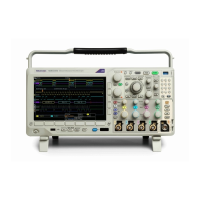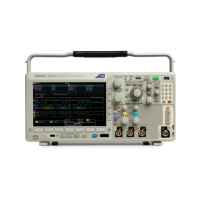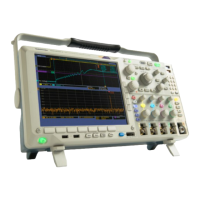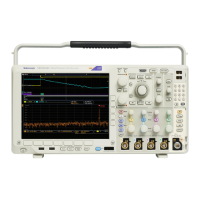4. The Zoom icon (in upper right corner of Waveform and Plot views) toggles zoom on and off.
5. The T
rigger Level Indicator icon(s) shows the trigger level(s) on the trigger source waveform. Some trigger types require two trigger
levels.
6. Measurement and Search badges show measurement and search results. See Badges on page 50. See Add a
measurement on page 72.
7. The Results Bar Handle opens or closes the Results bar to maximize waveform screen viewing when needed. To reopen the
Results bar, either tap the handle icon or swipe left from the right side of the display.
8. The System badges show global instrument settings (Horizontal, Trigger, Acquisition, Run/Stop status, and Date/Time). See
Badges on page 50.
9. The Inactive Channel buttons add channel waveforms to the Waveform view and add an associated Channel badge to the Settings
bar.
The Add Math Ref Bus button expands allowing you to add a math, reference, or bus waveform to the Waveform view and add an
associated Waveform badge to the Settings bar.
The RF button activates the frequency domain display and adds an RF badge. Double-tap the badge to open the RF configuration
menu to configure the RF input. This button is only active if one of the RF options is enabled.
The AFG button opens the AFG configuration menu to set and enable the AFG output. This button is only present if the AFG option
is installed.
The DVM button lets you use an analog probe to take DC, AC RMS, or DC+AC RMS voltage measurements on your DUT. Tap the
button to add a DVM badge to the Results Bar and open a configuration menu. The DVM option also enables a trigger frequency
counter, accessible from the Mode & Holdoff panel in the Trigger badge menu. This button is only present if the DVM option is
installed.
10. Double-tap a badge to open its associated configuration menu. See Badges on page 50. See Configuration menus on page 54.
If you add more Channel or Waveform badges than can fit in the waveform badge display area, tap the scroll buttons at each end of
the waveform badge area to scroll and display hidden badges.
11. The Waveform Handles on each waveform identify the source of that waveform (Cx for channels, M for Math, Rx for Reference
waveforms, Bx for bus waveforms). The waveform handles are at the zero-volt level of the waveform by default. The currently
selected waveform handle is a solid color; unselected waveform handles are outlined.
Double-tapping a waveform handle opens the configuration menu for that waveform.
For digital channels, the waveform handle shows the channel number, with each individual digital signal labeled D0–D15 and
displayed with a different color.
Getting acquainted with your instrument
3 Series Mixed Domain Oscilloscope Printable Help 46

